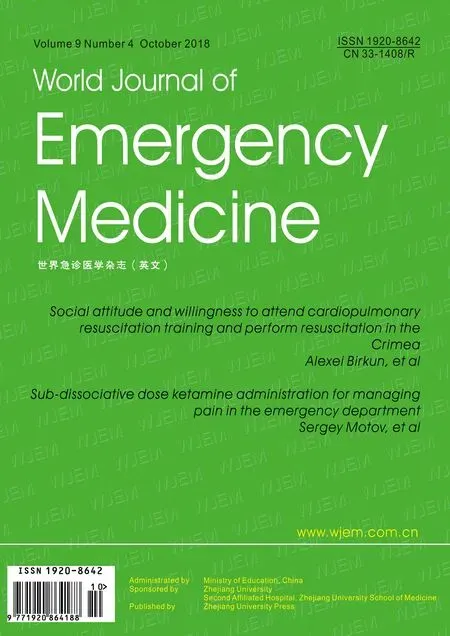Emergency department diagnosis of an ovarian inguinal hernia in an 11-year-old female using pointof-care ultrasound
Richard Amini, Nicola Baker, Dale P. Woolridge, Angela B. Echeverria, Albert Amini, Srikar Adhikari
1 Department of Emergency Medicine, The University of Arizona, Tucson, AZ, USA
2 Department of Emergency Medicine, Northwest Medical Center, Tucson, AZ, USA
3 Department of Surgery, Baylor College of Medicine, Houston, TX, USA
4 Arizona Premier Surgery, Chandler, AZ, USA
CASE
An 11-year-old girl presented to an emergency department (ED) with the complaint of sudden onset bulging mass in the left groin. The patient stated that she had a sudden onset of pain after wrestling with her brother and subsequently noticed the mass in her left groin. Due to the patient’s persistent pain and nausea, she was brought in to be evaluated. Upon presentation, the patient was noted to be well appearing and in noticeable pain. On exam, the patient had a palpable inguinal mass.The mass was firm, and there was no discoloration of the skin. The physician immediately attempted to reduce the mass but was unsuccessful. Prior to the second failed attempt at reduction, the patient was placed in Trendelenburg position, an ice pack was applied to the affected groin, and intravenous pain medications were administered. Due to the possibility for incarceration and the need for surgical evaluation, the patient was transferred to a tertiary care hospital for surgical evaluation. No further manipulations, imaging, or lab studies were performed in order to facilitate rapid transfer.
Upon arrival to the tertiary care ED, the patient was pain free, did not have systemic symptoms, but continued to have a firm mass in her left groin. The emergency physician immediately performed a pointof-care ultrasound of the inguinal region and the fi ndings were consistent with a herniated ovary (Figures 1–4). The pediatric surgeon was consulted and arrived promptly. Ultrasound images and fi ndings were reviewed and discussed with the pediatric surgeon. As a result of the ultrasound imaging, the decision was made to take the patient directly to the operating room (OR). As the patient and OR were prepared, a radiology-performed ultrasound was obtained per the consultant’s request.The additional study did not alter patient management but confirmed the point-of-care ultrasound findings and diagnosis of herniated ovary. Surgical exploration revealed a well-perfused herniated ovary and fallopian tube through the inguinal canal. The patient’s ovary and fallopian tube were salvaged, and the patient was discharged without additional complications. Although the patient has not had subsequent genetic testing, the patient received a comprehensive pelvic ultrasound 2 years after the event that demonstrated normal appearing bilateral ovaries, an anteverted uterus with normal echotexture, and a uniform and homogenous endometrial stripe measuring 5 mm.

Figure 1. Left inguinal region superior to herniated ovary.

Figure 2. Left inguinal region in sagittal plane, demonstrating the left adnexa ventral to the left superior pubic ramus.

Figure 3. Left inguinal region with herniated left ovary.

Figure 4. Doppler ultrasound demonstrating normal appearing arterial fl ow to the left ovary.
DISCUSSION
Patients who present to the ED with complaints of an inguinal mass often have a primary attempt at manual reduction of the hernia by the emergency physician. This patient population is at risk for incarceration and subsequent ischemia, therefore current recommendations are to attempt gentle reduction with or without the use of sedation prior to emergent surgery.[14–16]When reduction is not successful,urgent consultation with the appropriate surgical specialty is obtained for repeat attempt at reduction or definitive operative repair. Although, the diagnosis of an inguinal hernia is generally made clinically by examining the inguinal canal and external genitalia, inadequate identification of the contents of inguinal hernias may lead to injury or complications. Point-of-care ultrasound can help the clinician evaluate the herniated anatomy and thereby consult the correct surgical specialists. In this case, reducing an ovarian hernia that has threatened blood supply can lead to torsion, necrosis and organ loss.
Traditionally, sonographic evaluation has been performed when attempts at manual reduction are unsuccessful. Ultrasound has been considered a valuable tool in the diagnosis of inguinal contents for many years. In fact, in 1984, Dr. Goske published a case series demonstrating the utility of using real-time ultrasound in the diagnosis of inguinal hernias with correct identifi cation of the contents of the hernia sac.[15,16]With high-frequency transducers, ultrasound has become very reliable in determining the hernia sac and assessing its content. In addition, evaluating the inguinal mass for vascularity or vascular compromise can be assessed by a simultaneous Doppler examination. Although Doppler can provide very useful information, clinicians should be aware that incomplete or intermittent ovarian torsion can demonstrate normal or increased arterial and venous fl ow. Additionally, the presence of fl ow does not necessarily rule out torsion because of dual blood supply to the ovary.[7,8]In our case, point-of-care ultrasound of the inguinal hernia prevented further attempts at manual reduction and facilitated rapid transfer to the operating room. A proposed algorithm for the management of incarcerated inguinal hernias is presented in Figure 5.

Figure 5. Therapeutic algorithm for incarcerated inguinal hernias.
By applying basic ultrasound skills in unusual presentations, emergency providers can decrease delays to definitive diagnosis and treatment. If the initial treating physicians in our case had performed the pointof-care ultrasound and found the herniated ovary, they likely would not have conducted numerous attempts at reduction. In addition, this patient could have potentially suffered ovarian torsion or necrosis had the consultant performed further reduction attempts.
CONCLUSIONS
Point-of-care ultrasound can prevent the misdiagnosis of complicated inguinal hernias, expedite consultation, and accelerate the appropriate management plan.
Funding:None.
Ethical approval:Not needed.
Conflicts of interest:The authors declare there is no competing interest related to the study, authors, other individuals or organizations.
Contributors:RA proposed the study and wrote the fi rst draft. All authors read and approved the fi nal version of the paper.

